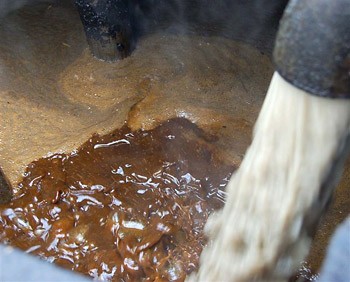From Bacon to Biofuel

Brown grease: a sewer pipe’s worst enemy.
Brown grease—a nasty mélange of leftover animal fat, pan scrapings and other gunky residue—is a sewer pipe’s worst enemy. In San Francisco, a pilot project led by two Berkeley Engineering alumni is in the works to explore for the first time how wastewater treatment plants throughout California might turn the unappealing stuff into biodiesel fuel.
Plans call for a test facility at the city’s Oceanside Water Pollution Control Plant to churn out 300 gallons of biodiesel a day from brown grease that typically winds up in restaurant grease traps or causes trouble when it’s improperly flushed down the drain. The venture is supported by a $1 million grant from the California Energy Commission.
“For the city, it’s going to be a win-win situation,” says Domènec Jolis (Ph.D.’92 CEE), a senior engineer at the San Francisco Public Utilities Commission (SFPUC) and the project’s co-principal investigator. The effort could potentially prevent messy and costly sewer backups and at the same time generate fuel for city vehicles and equipment as well as energy to run the sewage plant itself. Serving as the project’s manager is SFPUC principal engineer Jon Loiacono (B.S.’72 CEE).
By this fall, the managers hope to get the brown grease-to-biodiesel facility installed and running. The demonstration project would operate for one year. A primary goal is to provide public agencies statewide with a model for similar brown grease recovery programs. “We’re showing that the technology works and can be made commercially viable,” Jolis says, “and that it has a synergy with wastewater treatment plants.” An SFPUC report estimates that nearly 70 million gallons of brown or trap grease are generated annually in California.
The demonstration plant will be housed in a shipping-style container at the city’s wastewater treatment plant near the San Francisco Zoo.
For the project, the SFPUC will contract with outside vendors to provide and process the gunk. The grease must be prescreened several times to remove solid material (Jolis says it often contains “bones, forks, napkins, you name it”), then heated so it won’t congeal. After the initial treatment, it will undergo a chemical process called transesterification, which involves adding methanol and a catalyst, usually an acid, to the grease. The resulting products are glycerin, which is removed, and methyl ester, or biodiesel.

Domenec Jolis (Ph.D.’92 CEE) and SFPUC principal engineer Jon Loiacono (B.S.’72 CEE). (Photo by Meei-Lih Ahmad.)
A wastewater treatment plant is a logical place to house the grease recovery facility, the project managers say, because the grease has a high water content; water that’s removed during biodiesel production is expected to improve performance of the treatment plant’s anaerobic digesters and produce more methane gas. “It would be a great way to offset the power needs,” says Loiacono. Nationwide, wastewater treatment plants are big energy users, consuming 3 percent of the country’s electricity supply each year.
Brown grease recovery is a distinct—and more complicated—process than the one that converts used cooking oil or “yellow grease” into biodiesel. Through a San Francisco program called SFGreasecycle, the city is already turning 20,000 gallons of yellow grease collected each month into biodiesel for city vehicles, says Karri Ving, biofuel coordinator for the SFPUC.
“Brown grease is much more challenging” to convert to fuel, Ving adds. It’s also particularly troublesome when untreated. “One of the main causes for sewer backups for the city is grease and oil that congeal and block passage of wastewater,” Jolis says. Each year, San Francisco spends an estimated $3.5 million clearing the sewer backups that result.
The brown grease project “opens possibilities that are a little different from traditional wastewater treatment,” Jolis says. “The utilities need to look at these issues more holistically. I think a program like this one is giving us an opportunity to reduce our carbon footprint.”
